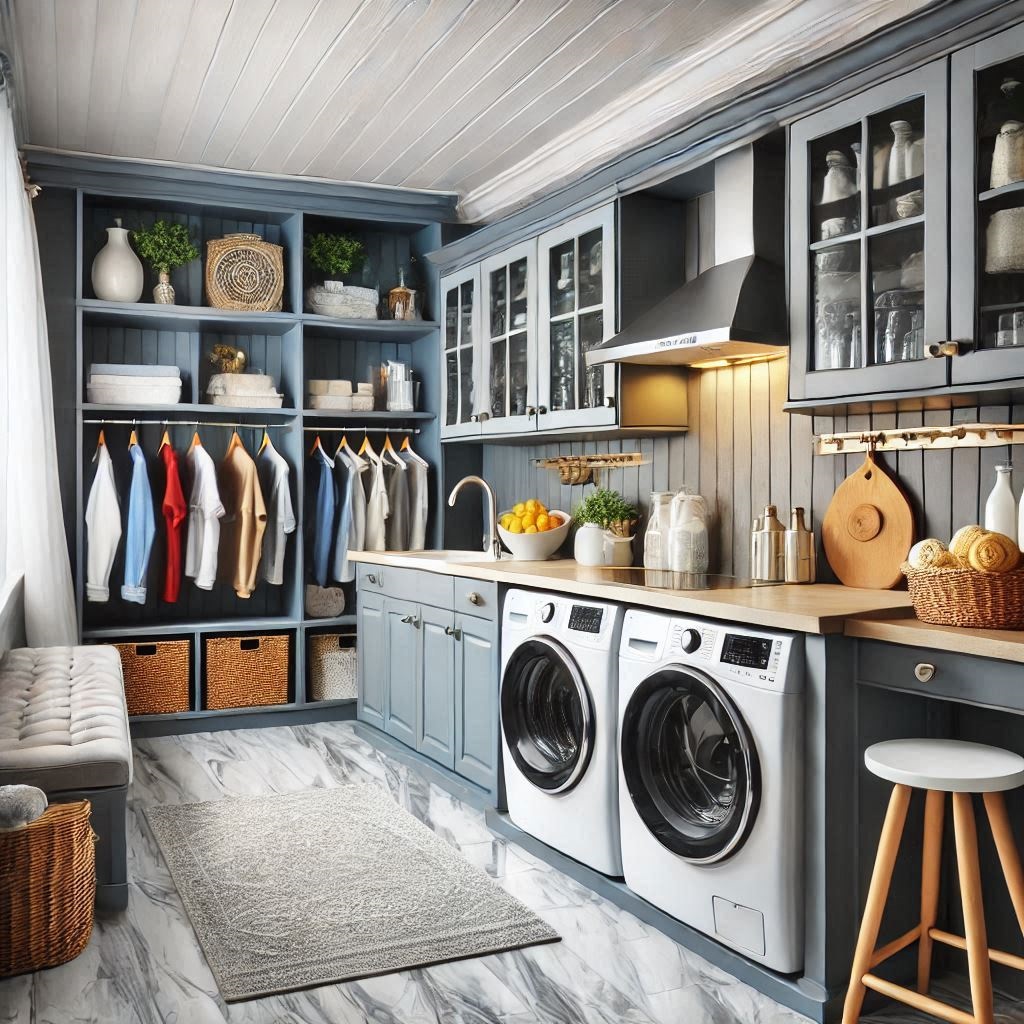
The utility room is often one of the most practical spaces in a home, yet it’s frequently overlooked in terms of design. Whether you’re building a brand-new utility room or renovating an old one, there are plenty of ways to maximise space, improve functionality, and make the area look great. Here are some key tips to consider for creating a utility room that works for your needs:-
1. Consider the Layout
When designing or renovating a utility room, it’s important to think about its flow and functionality. The layout should be efficient, making it easy to move between tasks like washing clothes, ironing, and storing cleaning supplies. If you have space, consider a work triangle (like in kitchens) to keep frequently used items close together. For example, the washer and dryer should be near each other, with counter space for folding clothes or sorting laundry in between.
2. Maximise Storage
Storage is key in a utility room, especially since it often houses cleaning supplies, laundry products, and other household items. Consider installing shelves or cabinets above the washer and dryer to store detergents, fabric softeners, and cleaning products. Adding built-in cupboards or pull-out drawers can keep things organised and hidden away. If you have the space, a utility room can also serve as a storage area for seasonal items like coats, boots, or gardening tools.
3. Opt for Durable Flooring
The floor in your utility room needs to withstand heavy use, spills, and moisture. Choose flooring materials that are durable, easy to clean, and water-resistant. Vinyl, ceramic tiles, and sealed hardwood are excellent choices. Avoid carpet, which can absorb moisture and stains. If you’re renovating, make sure to level the floor to prevent water from pooling in certain areas.
4. Install a Utility Sink
A deep utility sink can be a lifesaver, especially if you often need to wash muddy shoes, rinse out clothes, or clean your hands after gardening. A large, durable sink is a practical addition to any utility room, allowing you to easily handle dirty tasks without making a mess elsewhere in the house. If space allows, consider adding a drying rack or a clothesline above the sink.
5. Ensure Good Lighting
Utility rooms can often feel dark and cramped, so it’s important to install proper lighting. Overhead lighting is a must, but task lighting can also be beneficial, especially around work areas like folding tables or sinks. Consider using bright, energy-efficient LED bulbs to illuminate the space, and if the room is windowless, opt for warm, natural light to make it feel more inviting.
6. Ventilation is Key
Since utility rooms are often used for tasks like laundry and cleaning, proper ventilation is essential to prevent dampness and reduce odors. Install a ceiling fan or vent to keep the air circulating. If your utility room includes a dryer, ensure you have a proper exhaust system to prevent moisture buildup. This is especially important in smaller spaces where moisture can accumulate quickly.
7. Use Smart Appliances
Incorporating modern appliances can make a huge difference in the functionality of your utility room. Look for energy-efficient washing machines and dryers, which not only save on electricity bills but can also offer advanced features like quick wash cycles and steam options. If you’re building a new utility room, consider creating dedicated spaces for smart appliances, such as a smart fridge or a vacuum system, to streamline the process of managing household chores.
8. Keep It Organised
An organised utility room can make a big difference in the overall efficiency of your home. Consider using clear containers or labels for laundry supplies, and use hooks or baskets to keep cleaning products accessible but neatly stored. Invest in storage systems that make it easy to access what you need quickly, such as pull-out baskets, stackable bins, or drawer organisers.
9. Incorporate Multi-Functional Features
A utility room doesn’t just have to serve one purpose. If you have limited space, think about incorporating multifunctional features. For instance, a countertop can double as both a laundry folding area and a space for ironing or working on DIY projects. A fold-down drying rack or wall-mounted ironing board can also help you save space while still offering the functionality you need.
10. Add a Touch of Style
While functionality is important, don’t forget about aesthetics. Even a utility room can have character and charm. Choose a colour scheme that complements the rest of your home, or add stylish finishes like subway tiles, wood accents, or decorative storage baskets. With a few thoughtful touches, you can make your utility room both practical and visually appealing.
Conclusion
Whether you’re building a new utility room or renovating an existing one, making the space functional, organised, and aesthetically pleasing will make everyday chores much easier. By planning your layout carefully, incorporating smart storage solutions, and investing in durable materials, your utility room can become a space that works for you—keeping your home running smoothly and looking great.
If you’re looking for help to build a new utility room or renovate an existing one, remember you can post your job on Tradesmen.ie and get a number of quotes from rated carpenters, electricians, builders and lots more. With a range of service providers available, you’re sure to find the perfect fit for your project.
Best of luck creating the perfect utility room!
Cheers
Oliver Dempsey
Tradesmen.ie
20 December 2024
General Tips for hiring a tradesman
Here are some tips to consider when hiring a tradesman:-
1. Ask for phone numbers of references so that you can check them out
2. Check insurance of the tradesman where insurance is required
3. Hire a suitably qualified architect, building surveyor or building engineer if the job is anything to do with a new build, building renovation or extension






